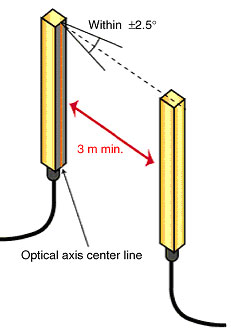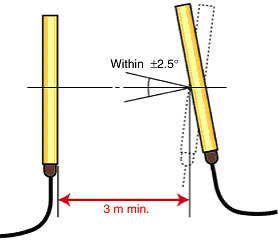Question
What is an effective aperture angle (directional angle)?
Answer
The effective aperture angle is the angle where the control output changes from ON (see note) to OFF when a Safety Sensor/Safety Light Curtain is rotated.
The angle is measured against the rotation around the optical axis center line and the pivot rotation direction.
Note: Control outputs for OMRON Safety Sensors/Safety Light Curtains are always ON when light is incident.
Example: When Using an F3SN-A Series Safety Light Curtains
F3SN-A Series effective aperture angle (directional angle) listed in the catalog specifications is within ±2.5° when the sensing distance for the emitter and receiver is at least 3m. This means that the effective aperture angle when the control output changes from ON to OFF when the optical center line is used as the axis of rotation (fig. 1) or the pivot point is used as the axis of rotation (fig. 2) is within ±2.5°.
Fig. 1 Using the Optical Axis Center Line as the Axis of Rotation

Fig. 2 Using the Pivot Point as the Axis of Rotation

Table of OMRON Safety Sensor/Safety Curtain Effective Aperture Angles (Directional Angles)
| Effective aperture angle (directional angle) | |
| F3SN-A-series Safety Light Curtains | ± 2.5° or less |
| F3SN-B-series Safety Light Curtains | ± 5° or less |
| F3SH-series Multi-beam Safety Sensor | ± 2.5° or less |
| F3SL-series Safety Light Curtain with Long-distance Sensing | ± 2.5° or less |
| F3SS-AT60P Single Beam Safety Sensor with Long-distance Sensing | ± 2.5° or less |
Recommended Products
 F3SR-B
F3SR-B
For Safety Light Curtain Robust & Basic New Lineup. Understanding the Indicators at a Glance.
 OS32C
OS32C
Compact (104.5 mm), lightweight (1.3 kg) and easy-to-install Safety Laser Scanner
 D40Z
D40Z
Supports ISO 13849-1 (PLe/Safety Category 4). Can be used on higher risk level applications by connecting to Safety Controllers.